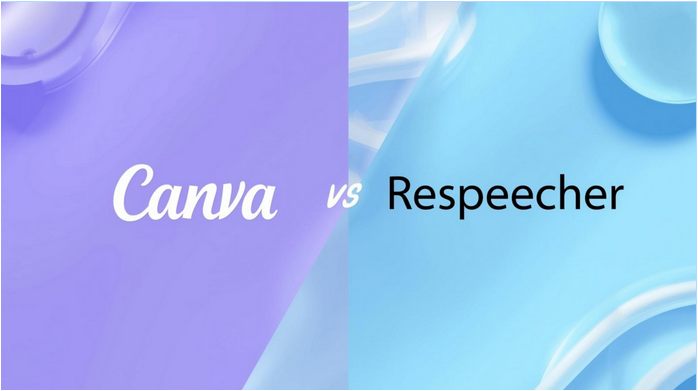
It wouldn’t be the case today that it was like a few years ago. Studio settings used to be done using a laptop and an internet-connected studio setup (edit, design or record sound). Two names that often appear in this space are canvas and respirators, but their purposes are very different.
Canva is a tool that many people use for quick slideshows, social posts, or simple videos. It also allows you to add background music or introduce your own narrative, which is handy when you need something quickly. Respeecher takes a completely different approach: it is built around sound. It offers technology instead of simple add-ons, but rather voice tracks to convince movie scenes, dubbing performances, or podcast episodes.
And, as viewers are paying more attention to voice than ever before, creators are exploring tools like this, especially when they want to try and try technologies like this Deep strike sound.
What canvas provides for creators

Many people turn to canvas when they need quick designs, slideshows or short videos without touching complex software. The platform hasn’t been stationary for years – now lets you play music and even record your own sound, so you can complete a project in one place.
Advantages of Canva sound characteristics:
- Integrate into a wider design platform to facilitate quick projects.
- Large inventory of audio and sound effects libraries.
- Simple voice recording tool for adding narratives.
limit:
- Voice functions are relatively basic and customization is limited.
- Recordings rely on the creator’s own voice or stock assets, which may not be suitable for professional-level needs.
- There is no advanced voice cloning or synthesis.
In short, Canva is perfect for adding quick voice tracks to presentations, reels, or social media posts, but not designed for creators who need quality voice production.
What respirator is brought to the table

Breathing is about human voice. Unlike many platforms that attempt to become creators of Swiss Army Knife, this is a sticking with a single craft: making the voice sound real. Not a robot, not a flat one. Real. There are pitch, rhythm, and even the little quirks you usually hear in studio recordings. That’s why you’ll find it behind the scenes of movies, campaigns and even some video games.
Key Benefits of Respirators:
- Voice cloning. Image: You have an old box telling a story, or just a typing script. The respirator can turn it into a new recording that still has pauses, focus and personality. It doesn’t feel like software, but a real person standing in front of the microphone.
- Professional projects. This is no longer a secret – respirators have been used in TV, movies and games. Studios rely on it for voiceover and character voice. Podcasts use it to keep narrative consistency so they don’t have to re-record every slip. Small teams that now require hours at the booth can now get the job done on their laptops.
- Moral License. Always worried about abuse of voice technology. The respirator handles this only by using a licensed sound. That way, there are no dark grey areas – only clear protocols that protect creators and those who use voices.
- Sound quality. What usually surprises newcomers is realism. The sound doesn’t stick out like the add-ons. They flow with rhythm and emotion. Put them next to real actors in movies or podcasts, and most listeners don’t know the difference.
It’s the real appeal: For creators who can afford studio time or voice actor teams, Respeecher opened a door. You can reach Polish that you once couldn’t reach, rather than just doing a simple narrative, whether you’re making a documentary, marketing location, or building a character for the game.
Key Differences between Canvas and Respirators
This is how the two platforms compare in terms of voice tools:
| feature | canvas | Respirator |
|---|---|---|
| Voice quality | Basic recording and stock audio | Reality, similar to human voice |
| custom made | Limited to simple editing | Complete voice cloning and synthesis |
| Use Cases | Speech, social posts | Movies, voiceovers, games, podcasts |
| license | Standard terms stock audio | Licensed Ethical Phonetic Rights |
| User level | Beginners and casual creators | Professionals and media teams |
This shows how respirators and canvas take a very different approach: canvas simplifies the creation of content, while Breath focuses on depth and realism in sound.
Use Cases: Which tool is suitable for your needs?
Choosing between a canvas or a respirator depends on what you want to achieve:
- Social Media Creator: If you are posting fast videos, reels, or simple voice narratives, Canva is usually enough.
- Podcast and Video Editor: Respeecher provides the ability to create professional voices, dubbing in multiple languages, and even restore the voices of historical figures to their original state.
- Educators and Marketers: Canva works for fast courses or advertising visuals, but when professional-grade audio storytelling is required, respirators add value.
- Media and Entertainment Team: Breath is the clear winner in movies, games and high-quality voice production.
Final thought: Canvas or respirators?
Both tools serve creators, but in very different ways. Canva is a versatile design platform with convenient voice add-ons, perfect for beginners and those working on fast-growing projects. But Respeecher is built for creators who want to push the boundaries of possibilities through voice – bringing lifelike results to professional media.


